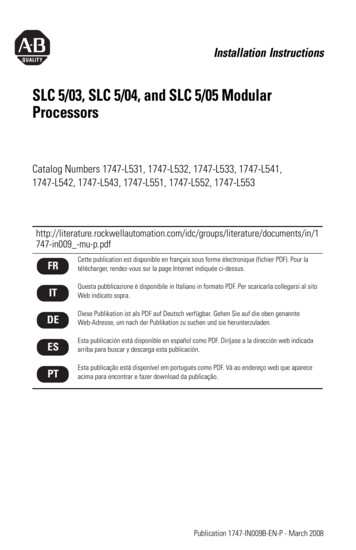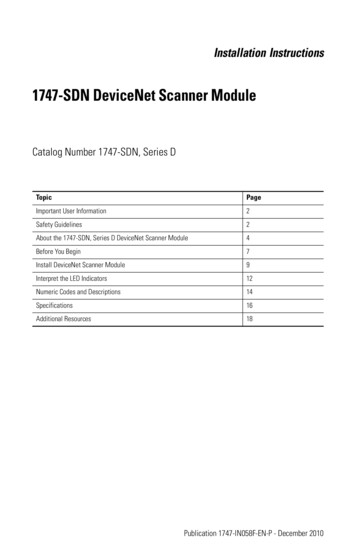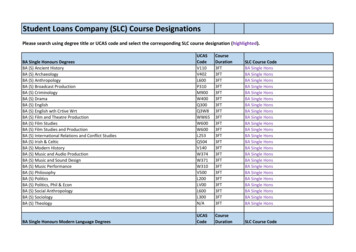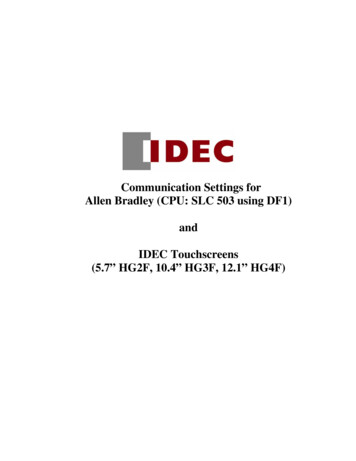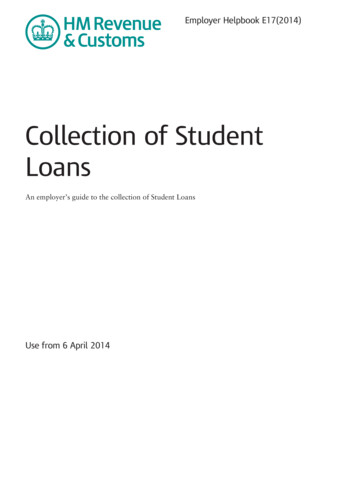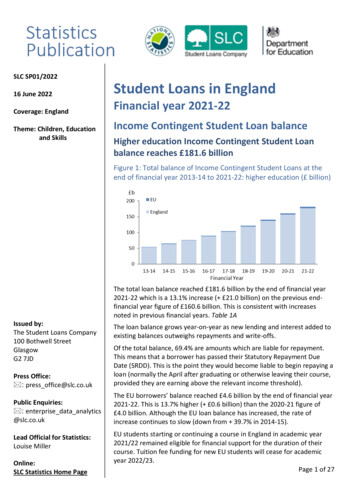
Transcription
SLC SP01/202216 June 2022Student Loans in EnglandCoverage: EnglandFinancial year 2021-22Theme: Children, Educationand SkillsIncome Contingent Student Loan balanceHigher education Income Contingent Student Loanbalance reaches 181.6 billionFigure 1: Total balance of Income Contingent Student Loans at theend of financial year 2013-14 to 2021-22: higher education ( billion)The total loan balance reached 181.6 billion by the end of financial year2021-22 which is a 13.1% increase ( 21.0 billion) on the previous endfinancial year figure of 160.6 billion. This is consistent with increasesnoted in previous financial years. Table 1AIssued by:The Student Loans Company100 Bothwell StreetGlasgowG2 7JDThe loan balance grows year-on-year as new lending and interest added toexisting balances outweighs repayments and write-offs.Press Office: : press office@slc.co.ukOf the total balance, 69.4% are amounts which are liable for repayment.This means that a borrower has passed their Statutory Repayment DueDate (SRDD). This is the point they would become liable to begin repaying aloan (normally the April after graduating or otherwise leaving their course,provided they are earning above the relevant income threshold).Public Enquiries: : enterprise data analytics@slc.co.ukThe EU borrowers’ balance reached 4.6 billion by the end of financial year2021-22. This is 13.7% higher ( 0.6 billion) than the 2020-21 figure of 4.0 billion. Although the EU loan balance has increased, the rate ofincrease continues to slow (down from 39.7% in 2014-15).Lead Official for Statistics:Louise MillerOnline:SLC Statistics Home PageEU students starting or continuing a course in England in academic year2021/22 remained eligible for financial support for the duration of theircourse. Tuition fee funding for new EU students will cease for academicyear 2022/23.Page 1 of 27
Further education Income Contingent Student Loan balance reaches 1.5billionFigure 2: Total balance of Income Contingent Student Loans at the end of financial year 2013-14 to2021-22: further education ( million)The loan balance for both England and EU further education borrowers reached 1.5 billion by the end offinancial year 2021-22. This is an 8.7% increase ( 124.2 million) on the previous end-financial year figureof 1.4 billion. Table 1BAlthough the balance continues to grow, the rate of increase has slowed consistently since 2014-15 (downfrom 199.6%).Of the total balance, 83.4% is amounts which are liable to repay meaning that the borrower has passedtheir SRDD. A more significant % than higher education balance due to the continued reduction in newloans issued.EU further education borrower’s balance reached 184.3 million by the end of financial year 2021-22. Thisis a 3.9% increase ( 6.9 million) on the previous end-financial year figure of 177.4 million. With a similartrend to higher education, although the EU loan balance continues to increase, the rate of increase hasslowed each year (down from 219.8% in 2014-15).In line with higher education support, EU students starting or continuing a further education course inEngland in academic year 2021/22 remained eligible for financial support for the duration of their course.However, this will also cease for new EU students for academic year 2022/23.The end financial year balance is net of 40.1 million in written-off loans. The vast majority of which ( 39.1million) is attributed to the ‘Access to HE’ policy. Student Finance England will 'write off' any outstandingfurther education loan (referred to as Advanced Learner Loans) balance owed for an eligible ‘Access to HE’course once the borrower has completed a higher education course.Comparing to the previous financial year, the amount written-off in relation to ‘Access to HE’ is asignificant 78.1% higher ( 17.1 million). This increase is predominantly due to the review and processingof a back-log of borrower accounts who would not have received an automatic write off e.g. self-fundedstudents.For more information on write-off policies, please refer to GOV.UK.Page 2 of 27
Table of contents (click for hyperlink)Income Contingent Student Loan balance1Introduction4What can you use these statistics for?4Things you need to know4Income Contingent Student Loan balance by repayment plan6Total amount paid out in loans to student borrowers7Interest added to Income Contingent Loans9Average Income Contingent Loan balances12Income Contingent Loan borrower repayment status14Income Contingent Loan repayments17Income Contingent Loan repayments by repayment method19Average amount repaid by repayment method23Additional information25Page 3 of 27
IntroductionThis statistics publication presents figures and observations on student loan outlays, repayments andborrower activity for England domiciled Student Loans Company (SLC) customers. This covers students whoare studying, or borrowers who have studied in higher education (HE) and further education (FE) in theUnited Kingdom (UK). Figures are also shown for European Union (EU) students studying in England.Figures provided here are for Income Contingent Repayment (ICR) Loans administered by SLC, which wereintroduced in academic year 1998/99.This publication covers financial years up to and including 2021-22.Complete information on student finance arrangements in England is available at the Student FinanceEngland website.What can you use these statistics for?These statistics can be used as a reference to the value of the Student Loans Company (SLC) loan balanceat the end of the financial year, student outlay within a financial year and information on borrower activityand repayment amounts.The data used in this publication is sourced from Student Loans Company’s ‘Customer Ledger AccountServicing System’ (CLASS). This system only holds information on borrowers who have received fundingfrom SLC. This publication also only includes information on loan products and does not includeinformation regarding grants and bursaries. Under normal circumstances grants and bursaries are notconsidered repayable.Due to this, these statistics cannot be used to analyse trends or to draw conclusions regarding the full UKeducation funding landscape.Things you need to knowMore Frequent Data Sharing (MFDS)From April 2019 the frequency in which repayments data is provided to SLC by HM Revenues and Customs(HMRC) increased. Before this SLC received customer repayment data, reported by employers, annuallyfrom HMRC after the end of the financial year. This increased to weekly. This meant for SLC customersbeing paid monthly through the Pay as You Earn (PAYE) system, SLC receives information of student loandeductions monthly.This increase in frequency resulted in a change in time series for repayments and interest applied for the2019-20 financial year. From the 2020-21 financial year, the time series has normalised with a single years’worth of repayments data being included (just those processed by SLC within that financial year).For more information on how this affected repayments and resulting interest calculations, please refer toour Additional information section and for additional detail, please refer to GOV.UK.Page 4 of 27
Self-Assessment dataSelf-Assessment repayment data is supplied from HMRC to SLC via a different process to PAYE. As a result,this will still be provided annually after the end of the financial year (and not weekly as for PAYEcustomers). This will therefore still show in the financial year in which it was posted to the customer’saccount, as in previous years. For this reason, financial year 2021-22 will mostly comprise of SelfAssessment repayments data from the previous financial year. This will also be true of the interestcalculations being applied for these borrowers.In Table 1A and 1B, in previous years we have had to mark the figures relating to Self-Assessmentrepayments as ‘estimated’ due to this being provided later than anticipated. From 2018-19 this has beenprovided as expected, allowing this to be included as final figures.In Table 4A and 4B we therefore mark the latest financial year of repayment as ‘provisional’ as the 2021-22Self-Assessment earnings information is received from HMRC after the 30 April effective date. The finalfigure is shown in the following years’ publication.Rounding, totals and averagesAll borrower numbers and amounts have been rounded to the nearest 100 and 100,000, the nearest 1decimal point on the data tables given. Average amounts are rounded to the nearest 10. Totals andaverages are calculated from un-rounded numbers, these therefore may differ from adding up roundedcomponents.Effective datesThe effective dates used in this publication are as follows:Table 1 and 2:Table 3, 4 and 5:31 March30 AprilTables 3, 4 and 5 provide information which requires annual PAYE end of year data supplied by HMRC toSLC, even after the introduction of MFDS. This is received after the financial year ends hence the latereffective date.Page 5 of 27
Income Contingent Student Loan balance by repayment planIn financial year 2021-22, there were three repayment plans. Students who began their course prior to 1September 2012 are on Repayment Plan 1, those who began their course on or after 1 September 2012 areon Repayment Plan 2 and students who have taken out postgraduate loans are on Repayment Plan 3.Borrowers can be ‘multi-plan’ should they have studied multiple courses.Plan 2 borrowing equates to over three-quarters of total Income ContingentStudent Loan balance in financial year 2021-22Figure 3: Total balance of Income Contingent Student Loans at the end of financial year 2013-14 to2021-22: higher education by repayment plan type ( billion)Figure 3 indicates the changing proportion of the loan balance in respect to repayment plan. At endfinancial year 2013-14, Plan 1 loans equated to 84.6% of the entire higher education loan balance and byend financial year 2021-22 this reduced to just 19.0%. This is as a result of no new Plan 1 loans being issuedfollowing the 2011/12 academic year. Table 1ADue to the replacement of Plan 1 with Plan 2 loans, the % of the balance attributed to Plan 2 loans hasincreased from 15.4% in financial year 2013-14, to 78.6% by the end of financial year 2021-22.Following their introduction in 2016-17, Plan 3 (postgraduate) loans now make up 2.4% of the total highereducation loan balance. For the first two financial years, this included purely Masters loans and from 201819, then included Doctoral loans.For more information on repayment plans types, please refer to our Income Contingent Student Loanrepayment plans & interest rates and calculations page.Page 6 of 27
Total amount paid out in loans to student borrowersLoans discussed in this section include Tuition Fee Loans and Maintenance Loans for undergraduates, andMasters and Doctoral Loans for postgraduates and Advanced Learner Loans for further education students.Total amount paid out in higher education loans increased by 5.0% to 19.8billion in financial year 2021-22Figure 4: Total amount paid in undergraduate loans in financial years 2013-14 to 2021-22 ( billion)Of the 19.8 billion paid out in the form of Income Contingent Loans in financial year 2021-22,undergraduate borrowers received 18.9 billion (95.4% of all loans paid). This was a 0.9 billion increase( 5.0%) in comparison to the previous financial year. Table 1AThe amount lent to undergraduates in the form of Tuition Fee Loans and Maintenance Loans has morethan doubled since financial year 2013-14, from 9.0 billion ( 109.6%).A total of 10.7 billion in Tuition Fee Loans was paid out on behalf of undergraduates in financial year2021-22, 2.6% more than in 2020-21. 10.3 billion was paid on behalf of England-domiciled students and a further 457.8 million on behalf ofEU-domiciled students.The 3.4% increase ( 333.6 million) in the amount paid on behalf of England-domiciled students wasoffset by an 11.5% decrease (- 59.6 million) in the amount paid on behalf of EU students. This is the firstreported decrease in EU undergraduate tuition fee funding, likely due to the changes in EU student fundingpolicy. 8.2 billion was paid to undergraduate borrowers in the form of Maintenance Loans; a 0.6 billion increase( 8.4%) on financial year 2020-21. Year-on-year increases have reduced since peaking in 2017-18 at 19.4%.Page 7 of 27
Figure 5: Total amount paid in postgraduate loans in financial years 2013-14 to 2021-22 ( million)The amount paid out in the form of postgraduate loans reached 903.9 million in 2021-22, a 34.5 millionincrease ( 4.0%) on 2020-21. This is a significantly lower increase than the 20.1% increase ( 145.6million) noted in the previous year. Table 1AAn 8.9 million decrease (- 14.3%) is evident in regard to postgraduate loans paid to EU students incomparison to financial year 2020-21, at 53.4 million. This is in direct contrast to the 7.0% increase notedin the previous financial year. Despite reducing increases since 2017-18, this is the first reported decreasein EU postgraduate funding, likely due to changes in the EU student funding policy.Total amount paid out in further education loans continues to reduce infinancial year 2021-22, to 153.3 millionFigure 6: Total amount paid out in further education loans in financial years 2013-14 to 2021-22 ( million)A total of 153.3 million was paid in the form of Advanced Learner Loans to further education students infinancial year 2021-22; a decrease of 26.0m (- 14.5%) on the previous financial year. Table 1BThis is a more significant decrease than noted in the two previous financial years (of - 11.4% and - 3.4%respectively). 9.6 million was paid out to EU further education borrowers in 2021-22, 13.7 million less than in theprevious financial year (- 58.9%), likely as a result of the change to EU student funding rules.Page 8 of 27
Interest added to Income Contingent LoansThe interest charged on higher education loans is dependent on the repayment plan the loans falls under.In financial year 2021-22, there were three plans. Students who began their course prior to 1 September2012 are on Repayment Plan 1, those who began their course on or after 1 September 2012 are onRepayment Plan 2 and students who have taken out postgraduate loans are on Repayment Plan 3. Allfurther education loans (Advanced Learner Loans) fall within Plan 2 regulations. Borrowers can be ‘multiplan’ should they have studied multiple courses.Interest accrued on higher education loans remains relatively constant infinancial year 2021-22 at 4.7 billionFigure 7: Total amount of interest accrued on higher education loans in financial years 2013-14 to2021-22 ( billion)Despite a 14.6% increase in the opening balance in financial year 2021-22, the interest accrued onto highereducation loan accounts remained constant to that of the previous financial year, at 4.7 billion. This canbe attributed to lower interest rates charged in the majority of financial year 2021-22. Table 1AThe Department for Education (DfE) monitors interest rates set by commercial banks using monthly dataprovided by the Bank of England. From July 2021, as the average commercial interest rate (or PrevailingMarket Rate (PMR)) fell below the normal rate charged on these loans (normally ‘RPI’ (Retail Price Index) 3% (dependent on circumstance and income)). So to not disadvantage borrowers, a temporary cap was putonto both Plan 2 and Plan 3 interest rates.The PMR rate remained at below RPI 3% (at varying rates) from 1 July 2021 until 28 February 2022.Please refer to the Income Contingent Student Loan repayment plans & interest rates and calculationspage on GOV.UK for further detail.The accrued interest in 2021-22 equated to 2.9% of the financial year’s opening balance of 160.6 billion.This is lower than in the previous financial year, where the interest accrued equated to 3.3% of theopening balance, of 140.1 billion.The greater increase between 2018-19 and 2019-20 was predominantly due to ‘More Frequent DataShare’- the more readily available data provided to SLC by HMRC. This meant that effectively, almost twoyears’ worth of customer PAYE repayments and resulting interest calculations (those processed by SLC inPage 9 of 27
both financial year 2018-19 and 2019-20) were included in the 2019-20 financial year. The time seriesnormalised in financial year 2020-21, and since then only includes one financial year of interest calculations(just those processed by SLC in that financial year). Further detail can be found in the Additionalinformation section.The graph below indicates the amount of interest added by financial year, split by repayment plan type:Figure 8: Total amount of interest accrued on higher education loans in financial years 2013-14 to2021-22 by repayment plan ( billion) 398.4 million was accrued on Plan 1 balances in financial year 2021-22. This is a decrease of 30.0 million(- 7.0%) in comparison to 2020-21.Plan 1 interest represented 1.1% of the opening balance in both 2021-22 and in 2020-21. Plan 1 interestwill continue to decrease as these loans are repaid and no new loans issued. 4.1 billion was accrued on Plan 2 loan balances in the same period. This is consistent with financial year2020-21.As a % of the opening balance, Plan 2 interest represented 3.4% in 2021-22, and 4.1% in 2020-21,predominantly as a result of the aforementioned capped interest rate from July 2021 to February 2022. 182.7 million was accrued on Plan 3 loan balances in financial year 2021-22. This is an increase of 27.0million ( 17.4%) in comparison to 2020-21.As a % of the opening balance, Plan 3 interest represented 5.3% in 2021-22 and 6.3% of the openingbalance in 2020-21. The 2018-19 total is made up predominantly of Postgraduate Masters Loan interest, asthe Postgraduate Doctoral loan was not introduced until late into that financial year (for academic year2018-19).For more information on interest rates and calculations, please refer to our Income Contingent StudentLoan repayment plans & interest rates and calculations page.Page 10 of 27
Reduction in total interest accrued on further education loans in comparisonto financial year 2020-21, at 35.4 millionFigure 9: Total amount of interest accrued on further education loans in financial years 2013-14 to2021-22 ( million)Interest accrued on further education loan accounts equated to 35.4 million in financial year 2021-22.This is 8.8% less (- 3.4 million) than in 2020-21. Table 1BThis is a significantly smaller decrease then seen in the previous financial year (of -24.4%) owing to theoutlying year of 2019-20 due to MFDS.Of the 2021-22 financial year’s opening balance, the interest equated to 2.5%. This is a lower proportionthan the 3.1% noted in the previous financial year.As outlay has gradually decreased since 2016-17, this will slow the total interest being applied insubsequent years.Page 11 of 27
Average Income Contingent Loan balancesThis section looks at the average loan balance for borrowers at the point where their liability to repay firstbegan (usually the April following the completion, or withdrawal from their course, provided they areearning above the relevant income threshold). The average loan balance reflects the amount paid toborrowers, plus interest added whilst they were studying, minus any voluntary repayments made byborrowers prior to them becoming liable to repay.Average higher education borrower’s loan balance on entry into repaymentremains relatively consistent with previous year, at 45,150Figure 10: Average loan balance on entry into repayment-by-repayment cohort as at the beginningof the financial year 2022-23: Higher education 50,000England & EU 40,000EU Only 30,000 20,000 10,000 2020212022Repayment CohortThe average loan balance for the 2022 repayment cohort on entry to repayment was 45,150. This isrelatively constant with that of the 2021 repayment cohort ( 0.9% / 390). This increase is considerablylower than those noted in the two previous years of 11.9% and 12.2% respectively. Table 5A (iii)This is predominantly due to the significant majority of those entering repayment having taken loans postacademic year 2016/17 when Maintenance Loans were increased due to the discontinuation ofMaintenance Grants for new students, coupled with the increase in Tuition Fee Loans in academic year2017/18. For further information on available funding please refer to Table 1 of our latest Student Supportpublication.Full-time students completing three- or four-year courses are included in these averages but are diluted byother borrower types in the same repayment cohort such as those on longer or shorter courses, part timestudy and students that have withdrawn before completing their studies.For EU borrowers, the average balance for the 2022 repayment cohort on entry to repayment increasedfrom 26,170 to 26,980 ( 3.1% / 490). This is higher than the increase noted in the previous year, of1.9%, yet more in line with the increase noted in 2019 cohort, of 3.6%. Table 5B (iii)EU borrowers consistently have a lower average balance. This is predominately due to non-Englanddomiciled students being entitled to Tuition Fee loans only.EU students starting or continuing a course in England in academic year 2021/22 remained eligible forfinancial support for the duration of their course. Tuition fee funding for new EU students will cease foracademic year 2022/23.Page 12 of 27
Small increase in average further education borrower’s loan balance on entryinto repayment, at 3,200Figure 11: Average loan balance on entry into repayment by repayment cohort as at the beginningof financial year 2022-23: Further educationFor the 2022 repayment cohort the average balance for a further education borrower on entry intorepayment was 3,200. This is an increase of 110 ( 3.6%) on the prior years’ repayment cohort of 3,090.Table 5A (vi)This increase is more significant than those noted in the previous two cohort years of 1.3% ( 40) and 0.7% ( 20) respectively.Overall, the average further education borrower balance has increased by 640 ( 25.0%) since the 2016repayment cohort.Page 13 of 27
Income Contingent Loan borrower repayment statusBorrowers are categorised by their repayment status as at the end of the financial year. This status maychange throughout the year depending on borrowers changing circumstances.65.5% of all higher education ICR borrowers who are liable to repay are in theUK tax system and 35.2% made a repayment in financial year 2021-22Figure 12: ICR student loan borrowers by repayment status as at the beginning of FY 2022-23(higher education)The above chart includes all higher education ICR loan borrowers in all repayment cohorts who havebecome liable to repay as at 30 April 2022. Table 3A (i) and (ii)Included in these figures, is the 2022 repayment cohort. This cohort has been in repayment for less thanone month from the effective date of these statistics, therefore the profile of this repayment cohort is verydifferent to that of earlier repayment cohorts.The number of borrowers (who are liable to repay and) who were in live employment and made arepayment in financial year 2021-22 was 2.2 million, an increase on the end-April position in 2021 of 2.1million. As a % of all those liable to repay, this has remained relatively constant at 35.2% (vs. 36.0% in2021).The number of borrowers in the UK tax system, yet not required to make a repayment reached 1.2 millionin April 2022, compared to 1.0 million in the previous April. As a % of all those liable to repay, thisrepresents 19.0%, slightly higher than the 17.6% noted at the same point in 2021.The number of borrowers liable to repay showing no live employment for less than 90 days increased from36,200 to 50,300 by 30 April 2022. However, as a % of all those liable to repay, this remained relativelyconstant at 0.8% (vs. 0.6% in 2021). Those showing no live employment for over 90 days reached 135,100,lower than the 147,200 noted in April 2021. As a % of all those liable to repay, this also remained relativelyconstant at 2.1% (vs. 2.5% in 2021).Page 14 of 27
At end-April 2022, of those overseas and above earnings thresholds for that country, the number of thosewho made repayments increased by 8,700 in comparison to April 2021 (to 54,700) and the number ofthose defaulted in arrears has increased by 1,500 to 49,500. As a % of all those liable for repayment, bothof these categories remained relatively unchanged (at 0.9% and 0.8% respectively).21.8% of those who are liable to repay at end-April 2022 no longer retained any loan balance, mainly dueto full repayment (consistent with April 2021 at 21.3%).At end-April 2022, of the 6.4 million borrowers, 5.0 million were still owing (up 6.9% and 6.3% respectivelyon 2021).For 30 April 2021 figures, please refer to Table 3A (i) and (ii) in our previous year’s publication.'Future cohorts' shown in Table 3 are borrowers whose SRDD (Statutory Repayment Due Date) has notbeen reached and are currently not liable to repay and includes borrowers who are still studying.The numbers in a repayment cohort can change. Students begin in a cohort based on the length of theircourse. If they drop out of their course of study, the date from which they are expected to start repaying(SRDD) is brought forward to the April following the date they withdrew from their course.As a result of MFDS, the number of borrowers within the tax system is now identified earlier as StudentLoans Company are no longer reliant on an annual, end-of-year HMRC file of data to allocate their status.66.2% of all further education ICR borrowers who are liable to repay are in theUK tax system and 14.3% made a repayment in financial year 2021-22Figure 13: ICR student loan borrowers by repayment status as at the beginning of FY 2022-23(further education)The above chart includes all further education ICR loan borrowers in all repayment cohorts who havebecome liable to repay as at 30 April 2022. Table 3A (iii) and (iv)Page 15 of 27
Included in these figures, is the 2022 repayment cohort. This cohort has been in repayment for less thanone month from the effective date of these statistics, therefore the profile of this repayment cohort is verydifferent to that of earlier repayment cohorts.The number of borrowers (who are liable to repay and) who were in live employment and made a paymentin financial year 2021-22 was 74,800, an increase on the end-April 2021 position of 63,300. As a % of allthose liable to repay, this has increased from 13.4% to 14.3%.The number in the UK tax system, yet not required to make a repayment reached 191,500 by end-April2022, compared to 165,200 in the previous April. As a % of all those liable to repay, this was 36.5%, slightlyhigher than the 34.9% noted at the same point in 2021.The number of borrowers liable to repay showing no live employment for less than 90 days increased from3,100 to 4,200 by 30 April 2022. However, as a % of all those liable to repay, this remained relativelyconstant at 0.8% (vs. 0.7%). Those showing no live employment for over 90 days totaled 8,800, lower thanthe 10,600 noted in April 2021. As a % of all those liable to repay, this reduced from 2.2% to 1.7%.At end-April 2022, of those overseas and above earnings thresholds for that country, the number of thoserepaying has increased by 60.9% to 200 in comparison to April 2021, and the number in arrears hasincreased by 32.4% to 300. As a % of all those liable for repayment, both categories remained relativelyunchanged (a negligible % at one decimal point).11.3% of those who are liable to repay at end-April 2022 no longer retained any loan balance, mainly dueto full repayment (an increase on the 9.2% noted in April 2021).At end-April 2022, of the 524,700 borrowers, 465,400 million were still owing (up 11.0% and 8.4%respectively on 2021).For 30 April 2021 figures, please refer to Table 3A (iii) and (iv) in our previous year’s publication.'Future cohorts' shown in Table 3 are borrowers whose SRDD (Statutory Repayment Due Date) has notbeen reached and are currently not liable to repay and includes borrowers who are still studying.Further education loans being cancelled tend to be higher than higher education loans due to ‘Access toHE’. Student Finance England will 'write off' any outstanding Advanced Learner Loan balance owed for an‘Access to HE’ course once the borrower has completed a higher education course. This is treated as acancelled loan within this publication and is also included within the ‘Account closed’ column.From July 2019, an Advanced Learner Loan (subject to meeting criteria defined in regulations) may becancelled and the borrower no longer be eligible to repay their loan or part thereof. This has occurred inexceptional circumstances, for example, when a course is no longer available due to the actions of theprovider (such as going into liquidation) and no resolution to continue study has been found – these caseswould be treated as a ‘cancelled’ loan within this publication and are also included within the ‘Accountclosed’ column in Table 3A (iii) and (iv).Page 16 of 27
Income Contingent Loan repaymentsBorrowers normally become liable to make repayments from the April following the completion of, orwithdrawal from their course, provided they are earning above the relevant income threshold.Repayments are either made via HMRC (either PAYE or Self-Assessment) or directly to Student LoansCompany in a scheduled or voluntary basis. Repayment terms including thresholds and interest rates differdepending on the repayment plan type the loan falls under.Higher education borrowers repaid 3.4 billion in financial year 2021-22, a12.8% increase on 2020-21Figure 14: Total amount repaid by higher education borrowers in financial years 2013-14 to 202122 by plan type ( billion)The total amount repai
Contingent Student Loan repayment plans & interest rates and calculations page. Student loan sales In 2013 the UK Government decided to sell a portion of student loans issued before 2012 (Plan 1 loans). This resulted in two loan sales, one in December 2017 and the other in December 2018, with a combined value of 3.6 billion.
